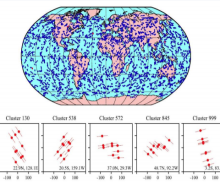Toward a Simulation - Retrieval System for Demonstrating Tomography of Internal Gravity Waves
Jennifer
Hegarty
Atmospheric and Environmental Research (AER), Lexington, Massachusetts, USA
Poster
Internal gravity waves transport momentum from the troposphere into the stratosphere and thereby play a significant role in regulating climatically relevant global circulation patterns such as the quasi-biennial and semi-annual oscillations and the Brewer-Dobson circulation. With radio occultation (RO) now operating on small satellites and CubeSats, it is possible and affordable to deploy close-formation constellation of RO satellites that would enable three-dimensional tomography of small spatial scale internal gravity waves to infer their momentum and energy fluxes. RO is very sensitive to gravity waves already because of its inherent vertical resolving power. A simulation system is needed, however, to demonstrate this technique and to perform trades studies to determine the density of the RO sampling network. We have constructed a simulation system for a theoretical demonstration of gravity wave tomography by “flying” a constellation of RO satellites through the Model for Prediction Across Scales (MPAS) configured to generate a realistic simulation of the emission of internal gravity waves from tropical deep convection. MPAS is a global model with a unique horizontal hexagonal mesh grid developed from Voronoi tessellations that can be stretched in some regions and compressed in other regions to provide higher spatial resolutions while retaining computational efficiency. In our study MPAS was run at a 15-km global resolution with a 3-km regional resolution over the western Pacific Ocean Warm Pool. This model grid resolution is well-suited to simulate gravity waves with scales down to 20-km horizontal wavelength; by using a global model, lateral boundary effects incurred from using limited area regional models such as WRF are avoided. We simulate RO retrievals of refractivity, bending angle, and temperature profiles adapting an existing multi-phase screen propagator tool to interface with meteorological inputs from MPAS paying careful attention to preventing interpolation discontinuities. The RO cases were selected to be climatologically representative of convectively active periods in the Warm Pool. The simulated refractivity and bending angle profiles are compared to those estimated from actual excess phase RO measurements. This study represents one of the first demonstrations of a RO retrieval simulation system utilizing the new global MPAS model featuring a stretchable resolution grid structure.

Poster PDF